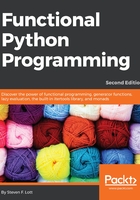
Understanding Functional Programming
Functional programming defines a computation using expressions and evaluation; often these are encapsulated in function definitions. It de-emphasizes or avoids the complexity of state change and mutable objects. This tends to create programs that are more succinct and expressive. In this chapter, we'll introduce some of the techniques that characterize functional programming. We'll identify some of the ways to map these features to Python. Finally, we'll also address some ways in which the benefits of functional programming accrue when we use these design patterns to build Python applications.
Python has numerous functional programming features. It is not a purely a functional programming language. It offers enough of the right kinds of features that it confers the benefits of functional programming. It also retains all the optimization power of an imperative programming language.
We'll also look at a problem domain that we'll use for many of the examples in this book. We'll try to stick closely to Exploratory Data Analysis (EDA) because its algorithms are often good examples of functional programming. Furthermore, the benefits of functional programming accrue rapidly in this problem domain.
Our goal is to establish some essential principles of functional programming. The more serious Python code will begin in Chapter 2, Introducing Some Functional Features.